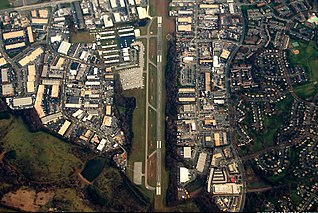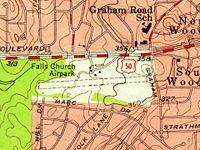
Capital Airlines was a United States trunk carrier, a scheduled airline serving the eastern, southern, southeastern, and midwestern United States. Capital's headquarters were located at Washington National Airport across the Potomac river from Washington, D.C., where crew training and aircraft overhauls were also accomplished. In the 1950s Capital was the fifth largest United States domestic carrier by passenger count after the Big Four air carriers.

Floyd Bennett Memorial Airport is a county-owned, public-use airport in Warren County, New York, United States. It is located three nautical miles (6 km) northeast of the central business district of Glens Falls, in the town of Queensbury. This airport is included in the National Plan of Integrated Airport Systems for 2011–2015, which categorized it as a general aviation facility.

Ardmore Airport is an airport 3 nautical miles (5.5 km) southeast of Manurewa in Auckland, New Zealand.

Katama Airpark is a public airport in the Katama section of Edgartown, Massachusetts, in Dukes County on the island of Martha's Vineyard. The airport, owned by the Town of Edgartown, has three runways, averages 22 takeoffs and landings per day, and has one aircraft based on its field.

Washington-Virginia Airport was an airport that was located in Fairfax County, Virginia from 1947 to 1970. The airport was mainly used for general aviation purposes until encroaching residential and commercial activities forced its closure.

Cincinnati Municipal Airport – Lunken Field is a public airport in Cincinnati, Ohio, 3 mi (4.8 km) east of Downtown Cincinnati. It is owned by the city of Cincinnati and serves private aircraft, including the fleets of local corporations. It serves a few commercial flights and is the second-largest airport serving Cincinnati after Cincinnati/Northern Kentucky International Airport, which is the area’s primary airport. It is known as Lunken Airport or Lunken Field, after Eshelby Lunken. It is bounded by US Route 50 to the west, US Route 52 and the Ohio River to the south, the Little Miami River to the east, and Ohio Route 125 to the north. The airport is headquarters and hub for Cincinnati-based public charter airline Ultimate Air Shuttle, serving 5 destinations in the eastern United States with 16 peak daily flights. Lunken is also home to small charter airline Flamingo Air and its aviation school.

Montgomery County Airpark is a U.S. public airport located three miles (5 km) northeast of the city of Gaithersburg, in Montgomery County, Maryland, United States.

Fallbrook Community Airpark, also known as Fallbrook Airpark, is a county-owned public-use airport two nautical miles south of the central business district of Fallbrook, in San Diego County, California, United States.
Air Park-Dallas Airport is a public airport located 16 nautical miles (30 km) northwest of the central business district of Dallas, in Collin County, Texas, United States. The airport is used solely for general aviation purposes. It was built as an airpark-style development, with adjacent homeowners having perpetual runway access guaranteed by restrictive covenants, but no formal ownership or management interest in the physical airfield facilities. The airport was formerly within the city limits of Hebron, Texas but was annexed by the city of Carrollton in 2008; the nearby residential lots were not included in the annexation.

Zamperini Field is a public airport three miles (5 km) southwest of downtown Torrance, in Los Angeles County, California, United States.

Major Harold Geiger was an American military officer and pioneer U.S. Army aviator, who was killed in an airplane crash in 1927. He was U.S. military aviator number 6. He was also a balloonist. Spokane International Airport is designated with the International Air Transport Association airport code GEG in his memory.

Brighton Airport is a public use airport located three nautical miles (6 km) north of the central business district of Brighton, in Livingston County, Michigan, United States.
This is a partial list of accidents and incidents involving the Boeing-designed B-17 Flying Fortress. Combat losses are not included except for a very few cases denoted by singular circumstances. A few documented drone attrition cases are also included.

Cornelia Fort Airpark was a privately owned, public-use airport located five nautical miles northeast of the central business district of Nashville, in Davidson County, Tennessee, United States. It was located on Cumberland River bottomland. It is named in honor of Nashvillian, Cornelia Fort, the first female pilot to be killed on war duty in American history. The airpark was built in 1945 near the Fort family farm. The 141-acre airport was located on part of a plot of land granted to early Nashvillian Ephraim McLean for service in the Revolutionary War, near what is still known as McLean's Bend in the Cumberland River in East Nashville. The airport operated from 1944 until 2011, when the city of Nashville acquired it to include it as non-aviation part of Shelby Park.
Braintree Airport was an airport located in the town of Braintree, Massachusetts from 1948 to 1968. The airport was used for general aviation purposes until encroaching residential development forced its closure.
Andrews University Airpark is a privately owned, public use airport located 2 miles west of Berrien Springs, Michigan. It is owned and managed by Andrews University, a Seventh Day Adventist university that manages an aviation department.


















